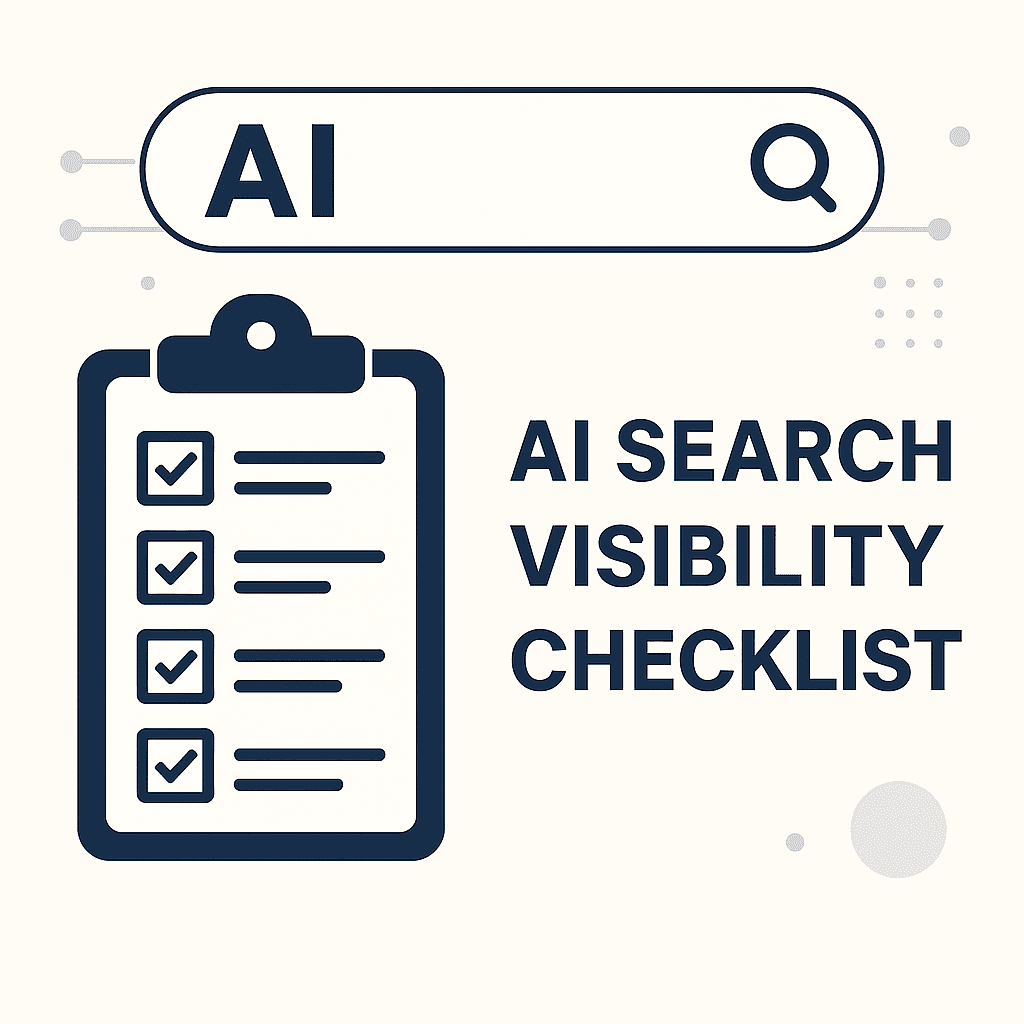AI Search Visibility Checklist: Optimize Your Website for AI
AI-powered search tools like ChatGPT and Google AI Overviews are changing how people find answers online. This checklist shows you how to optimize your site for maximum visibility, authority, and discoverability in AI-driven search results.
Artificial intelligence (AI) search assistants like ChatGPT, Perplexity, Bing Copilot, and Google AI Overviews are changing how people find information online. Unlike traditional search engines, these tools don’t just show links — they synthesize answers directly from websites. But how can Marketing leaders prepare their organization for this new age of online search?
A few months ago, I had many questions that I was looking to answer:
Does AI search visibility depend on SEO?
How do I make sure GPTBot can crawl my site?
How do I optimize my website for AI search engines?
How can I future-proof my site for AI search?
And many more...
The answers were scattered all over the internet. I discovered that there are many different blogs, entries and recommendations. The following should provide you an easy checklist and a comprehensive overview on how to optimize your website for AI.
If you want your site to appear in these AI-powered responses, you need to optimize not only for Google SEO but also for AI search visibility. This checklist will help you make your site AI-ready and future-proof.

AI Search Visibility Checklist – Minimalist Featured Image
Key Takeaways
AI search assistants are now a major discovery channel.
To be visible, your site must be fast, structured, factual, and trustworthy.
Structured data, AI-friendly formatting, and bot accessibility are non-negotiables.
Ongoing monitoring and adaptation are essential as AI search evolves.
1. Build a Solid Technical Foundation
AI crawlers, like search engine crawlers, rely on your site being accessible and fast. AI Search visibility build on technical SEO fundamentals.
✅ Ensure fast load speed (optimize Core Web Vitals: LCP < 2.5s, CLS < 0.1, INP < 200ms).
✅ Design with mobile-first principles — most AI tools fetch mobile content.
✅ Use HTTPS everywhere.
✅ Fix crawl errors (broken links, redirect loops, blocked pages).
✅ Provide an XML sitemap and submit it to Google Search Console and Bing Webmaster Tools.
✅ Keep your site architecture simple — most important content should be reachable within 3 clicks.
2. Add Structured Data (Schema Markup)
Structured data helps AI understand content structure and display richer formats. It is your AI visibility secret weapon.
✅ Implement Schema.org markup in JSON-LD format.
✅ Use the right schema types:
Organization / Person (company details, logo, contact info).
Article / BlogPosting for blog content.
FAQPage for Q&A content.
Product for e-commerce.
HowTo for tutorials.
✅ Add metadata:
title,description,author,datePublished,dateModified.✅ Mark up images with descriptive
alttext and captions.
3. Optimize Content for AI Readability
AI models extract facts and clear answers, not fluff.
✅ Write in natural, conversational language.
✅ Use headings and subheadings to pose and answer real questions.
✅ Add FAQ sections with direct answers.
✅ Place key takeaways or TL;DR summaries at the top of articles.
✅ Use lists, tables, and bullet points to structure information.
✅ Keep content fresh — update regularly.
4. Build Trust and Authority (E-E-A-T)
AI systems prefer content from trustworthy sources.
✅ Show author bylines with credentials.
✅ Include About, Contact, Privacy, and Terms pages.
✅ Link to credible external sources (.gov, .edu, peer-reviewed).
✅ Acquire quality backlinks from authoritative websites.
✅ Maintain consistent branding across your site and profiles.
5. Optimize Media for AI
AI crawlers can parse text but struggle with media unless it’s supported with metadata.
✅ Use high-resolution images with alt text.
✅ Add video transcripts and closed captions.
✅ Provide downloadable resources (PDFs, CSVs) with descriptive metadata.
✅ Use clear file names for images and documents.
6. Monitor Indexing and AI Crawler Access
If AI bots can’t crawl your site, you won’t show up in results.
✅ Submit your site to Google Search Console and Bing Webmaster Tools.
✅ Monitor index coverage and fix excluded URLs.
✅ Check server logs for visits from AI crawlers like GPTBot (OpenAI), PerplexityBot, and CCBot (Common Crawl).
✅ Allow AI bots in
robots.txtunless you intentionally want to block them.
7. Encourage Engagement and Reputation
Social and user signals help reinforce authority. PR is essential for AI search visibility.
✅ Enable comments, feedback forms, or discussion features.
✅ Share content on LinkedIn, X (Twitter), and niche communities.
✅ Earn mentions in newsletters, podcasts, or forums.
✅ Encourage others to cite and link to your content.
8. Future-Proof for AI Search
AI search is evolving quickly. Prepare your site to adapt.
✅ Create a dedicated AI-ready page summarizing your expertise in bullet points.
✅ Publish structured resources: glossaries, timelines, datasets, APIs.
✅ Monitor how AI tools summarize your site (ask ChatGPT or Perplexity directly).
✅ Keep experimenting with formats that AI systems can parse easily.
Feel free to use this framework to prepare for AI search in 2025 and 2026. It will make your life easy to get the AI search results you want.

Peter Frank
GEO Strategist
Ready to Optimize for AI Search?
Join thousands of marketers who are already using LLMScout to track and improve their performance in AI search results.
Get Early Access